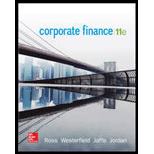
Corporate Finance (The Mcgraw-hill/Irwin Series in Finance, Insurance, and Real Estate)
11th Edition
ISBN: 9780077861759
Author: Stephen A. Ross Franco Modigliani Professor of Financial Economics Professor, Randolph W Westerfield Robert R. Dockson Deans Chair in Bus. Admin., Jeffrey Jaffe, Bradford D Jordan Professor
Publisher: McGraw-Hill Education
expand_more
expand_more
format_list_bulleted
Concept explainers
Question
Chapter 12, Problem 1QP
Summary Introduction
To determine: The Revised Expected Return.
Introduction:
A factor model is a numerical computation of the level to which
Expert Solution & Answer
Want to see the full answer?
Check out a sample textbook solution
Students have asked these similar questions
What is the difference between a contra asset account and a liability?i need help.
What is the significance of a company’s price-to-earnings (P/E) ratio? i need answer.
What is the significance of a company’s price-to-earnings (P/E) ratio?
Chapter 12 Solutions
Corporate Finance (The Mcgraw-hill/Irwin Series in Finance, Insurance, and Real Estate)
Ch. 12 - Prob. 1CQCh. 12 - Prob. 2CQCh. 12 - Prob. 3CQCh. 12 - Prob. 4CQCh. 12 - Market Model versus APT What are the differences...Ch. 12 - APT In contrast to the CAPM, the APT does not...Ch. 12 - CAPM versus APT What is the relationship between...Ch. 12 - Prob. 8CQCh. 12 - Data Mining What is data mining? Why might it...Ch. 12 - Prob. 10CQ
Ch. 12 - Prob. 1QPCh. 12 - Factor Models Suppose a three-factor model is...Ch. 12 - Prob. 3QPCh. 12 - Multifactor Models Suppose stock returns can be...Ch. 12 - Prob. 5QPCh. 12 - Market Model The following three stocks are...Ch. 12 - Prob. 7QPCh. 12 - Prob. 8QPCh. 12 - APT Assume that the following market model...Ch. 12 - Prob. 10QP
Knowledge Booster
Learn more about
Need a deep-dive on the concept behind this application? Look no further. Learn more about this topic, finance and related others by exploring similar questions and additional content below.Similar questions
arrow_back_ios
SEE MORE QUESTIONS
arrow_forward_ios
Recommended textbooks for you
 Intermediate Financial Management (MindTap Course...FinanceISBN:9781337395083Author:Eugene F. Brigham, Phillip R. DavesPublisher:Cengage Learning
Intermediate Financial Management (MindTap Course...FinanceISBN:9781337395083Author:Eugene F. Brigham, Phillip R. DavesPublisher:Cengage Learning
 EBK CONTEMPORARY FINANCIAL MANAGEMENTFinanceISBN:9781337514835Author:MOYERPublisher:CENGAGE LEARNING - CONSIGNMENT
EBK CONTEMPORARY FINANCIAL MANAGEMENTFinanceISBN:9781337514835Author:MOYERPublisher:CENGAGE LEARNING - CONSIGNMENT

Intermediate Financial Management (MindTap Course...
Finance
ISBN:9781337395083
Author:Eugene F. Brigham, Phillip R. Daves
Publisher:Cengage Learning


EBK CONTEMPORARY FINANCIAL MANAGEMENT
Finance
ISBN:9781337514835
Author:MOYER
Publisher:CENGAGE LEARNING - CONSIGNMENT
Portfolio return, variance, standard deviation; Author: MyFinanceTeacher;https://www.youtube.com/watch?v=RWT0kx36vZE;License: Standard YouTube License, CC-BY